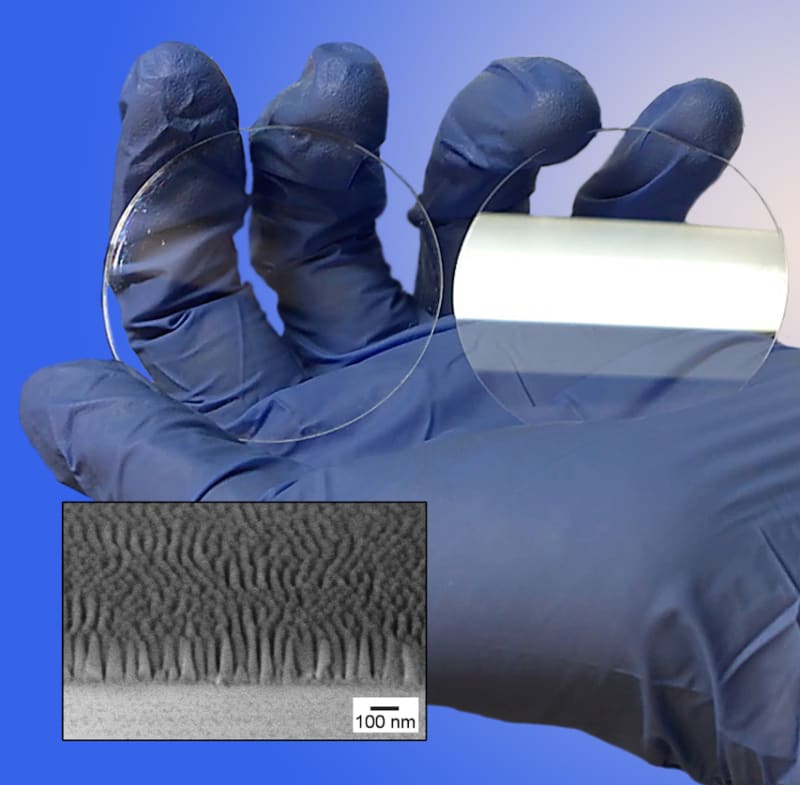Creators of an "Invisible Glass" were awarded top honors in this year’s "Create the Future" Design Contest. The grand-prize-winning fabrication method imparts anti-reflection and water-repellency capabilities to surfaces made of silicon, glass, and some plastics, including Teflon.
The annual " Create the Future" competition, launched in 2002 by Tech Briefs magazine, aims to encourage and reward engineering innovation. The nanotexturing technique, developed at the U.S. Department of Energy’s Brookhaven National Laboratory, was presented first place by senior editors at Tech Briefs Media Group and an independent panel of design engineers.
Because Brookhaven's texturing is engineered into the glass itself, no retroactive application of a coating is required.
The geometry of the surface itself is changed at the nanoscale, offering greater light reflection compared to polished silicon. When the fabrication technique is applied to both sides of a glass window, more than 99.7% of incident visible light is transmitted — making the glass essentially invisible.
The creators of the Invisible Glass see a range of possible applications for their invention. The nanotextured silicon, for example, could improve the performance of silicon solar cells, which must collect as much sunlight as possible.
In addition to reducing glare, the Invisible Glass also repels water — a valuable feature for cars and aircraft windshields.
“There are a lot of places where this [glass] can be useful, and that’s what has us most excited,” said Charles Black, a nanoscientist at Brookhaven National Laboratory, who along with his team took home the “Create the Future” grand prize of $20,000.
See the full details for Brookhaven's Invisible Glass .

In addition to the grand prize of $20,000, first-place “Create the Future” winners were named in seven categories:
Electronics/Sensors/IoT (sponsored by Mentor Graphics ): Future Antenna Miniaturization Mechanism: Magnetoelectric Antennas
New ultra-small antennas offer unique properties in bio-medical devices, wearable antennas, and the Internet of Things (IoT).
Robotics/Automation/Manufacturing (sponsored by Maplesoft ): Don't Melt. MELD.™
MELD is an innovative way to 3D print large metal parts — without melting the metal.
Medical (sponsored by Zeus ): Implantable Sensor Technology Platform for Advanced Prosthetic Control
The Implantable Myoelectric Sensor (IMES) system contains small sensors that can be implanted in the residual muscles of an amputee, enabling better control and more natural movements in a robotic hand, wrist, knee, or other prosthetic device.
Aerospace & Defense: Detecting Plastic Landmines
By combining drone technologies and infrared thermal imaging sensors, a system was created that can fly over affected areas and identify plastic landmines by their heat signatures.
Automotive/Transportation: ISCAD
VOLABO invented the first 48V drive with performances up to 300 kW. Thanks to a virtual gearbox, efficiency can be increased by 25% compared to conventional electric drives.
Consumer Products: Aluminum-Powered Electricity Generation
A team converted recycled aluminum into a highly energy-dense, shelf-stable, safe fuel that produces kilowatt-scale electricity.
Sustainable Technologies: Aerogels from Environmental Wastes for Novel Engineering Applications
A recycling technique turns waste into aerogels, for applications ranging from oil-spill cleanup to heat/sound insulation
For more information on all "Create the Future" contest entries, visit www.createthefuturecontest.com .

